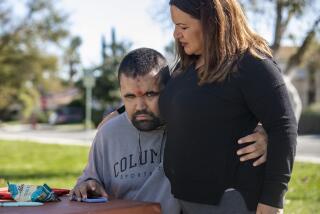A Healthy Spirit : Dean La Zar Builds Friendships While Battling a Cruel Genetic Disorder
- Share via
NORTHRIDGE — It was supposed to be a relaxing Mother’s Day visit with his parents, but early on, there were signs of trouble.
Though cool inside the family’s den, Dean La Zar’s hair dripped with sweat. Veins stood out on his neck and he sucked in sharp breaths. Suddenly, twisting his 85-pound frame sideways in his wheelchair, La Zar looked at his father, Sheldon, cocked back his wet head and spat at him.
“I’m . . . I’m TRYING!” La Zar yelled out, uttering the bywords of his tortured life.
At 32, La Zar is one of the world’s oldest living people with Lesch-Nyhan syndrome, a rare and eventually lethal genetic disorder characterized by compulsive, often obscene outbursts, spitting and self-destructive behavior including head-banging, hitting, lip-chewing and finger-biting.
But the strangest thing about La Zar may be this: For all the repulsive, antisocial behavior he is powerless to prevent, he not only manages to make friends but to keep them. Among intimates, and at the United Cerebral Palsy/Spastic Children’s Foundation in Van Nuys where La Zar spends most weekdays, he may be a medical oddity but he’s also an intelligent, perceptive human being.
Once he feels at ease with a person or situation, La Zar can turn on the charm and transform--albeit briefly--from “the little heathen,” as some friends call him, to a prince. Though his speech is impeded, he jokes, flirts, talks about sports and world affairs, and surprises people with his memory for personal details about them.
“He has this awful, horrible medical condition, but he also has this way of getting into your heart,” said Aram Kadish, an occupational therapist who has known La Zar about five years. “He’s hilarious--you just have to get to know him.”
*
La Zar was born the year before the outlandish illness was described for the first time by Dr. William Nyhan, then a faculty member at the Johns Hopkins University Medical School in Baltimore, and a young intern named Michael Lesch. They discovered that a genetically caused chemical imbalance was creating a surplus of uric acid, which in turn triggers a series of nervous reactions and exaggerated symptoms of anxiety. That was in 1964. Today, researchers are still baffled by why the condition affects the brain as it does.
Infants with Lesch-Nyhan seem normal at birth, but the illness usually appears by age 2 and can kill by age 15 if the amount of uric acid accumulating is enough to shut down the patient’s kidneys.
In La Zar, one of an estimated 150 Lesch-Nyhan patients nationwide, uric acid production is tempered by allopurinol, but the drug does not curb the neurological problems that Nyhan says “look for all the world like cerebral palsy.”
Yet La Zar, as he continues to defy the limited life expectancy of Lesch-Nyhan patients, also bests the destructive chemical and neurological forces within him, touching friends and family daily.
After the Mother’s Day incident--the first of several outbursts of the afternoon--Marlene La Zar rushed in from the kitchen. Wrapping her son’s sopping head in her arms and kissing him, she smiled warmly: “You’re doing all right, honey. We know you’re trying.”
La Zar looked up at her. “Can you dry me, please?” he asked politely.
Despite his disturbing behavior, his parents have come to understand why their only son acts the way he does. It is not always easy, especially for Marlene La Zar, who was an unwitting carrier of the defective chromosome that causes the syndrome. Today, tests are available that can detect the condition prenatally.
“I grit my teeth sometimes,” Marlene La Zar said, noting that even now her son will still greet her on the phone with obscenities. “After all these years, he still gets my goat.”
Still, La Zar manages occasionally to outwit the beast inside him, finding ways other than words to convey his love for his parents. As a student at Valley College in 1988, La Zar, acting on his own, contacted a rabbi and began studying for his bar mitzvah, in part because he wanted to, but in part to please his parents.
“I was crying,” La Zar recalled of the day that marked his ritual passage as a young Jew into manhood. “My mom was crying. Everyone was happy.”
And, though jealous at first of his new nephew Alexander, the son of his sister, Lisa, La Zar has spent more than a year of painstaking work on a hand-stitched teddy bear for the toddler. The project isn’t easy for a man with his lack of motor control. He slowly pulls one thread through at a time, with help from an aide.
*
La Zar also has managed to build bridges with those outside his family.
At summer camp when he was younger, La Zar once charmed a firefighter into sneaking him onto the truck during calls. It is one of his fondest memories, and once sparked a desire in him to be an emergency dispatcher. La Zar smiled when he thought about it. But asked if he thought he could really do it someday, he paused and replied truthfully: “No.” The smile faded.
His frustration manifests itself in different ways. Years later, La Zar would call 911 and falsely tell the dispatcher that his group home was burning down. The first time he did it, firefighters severely reprimanded him. The second time, they were furious, threatened to arrest him and demanded that his phone privileges be taken away.
He finagles kisses regularly from female aides at the cerebral palsy foundation, where he also has been known to bet on Lakers basketball games with staff members.
He became fast friends with a married couple--Lisa and Troy Searer--who visit him nearly every weekend. Lisa Searer met La Zar when she was an administrative assistant at the foundation, and though she changed jobs several years ago, she has continued her friendship with him.
“Dean will, on a fairly regular basis, try to kill you,” his physical activity instructor, Michael Borem, said with a straight face, as he helped La Zar into a metal apparatus with rollers designed to help him walk at the foundation. There, La Zar participates in a series of weekday classes and independent-living programs.
By mutual agreement with his parents, he lives in his own apartment within a group home in Sylmar for people with disabilities. Despite the constant threat of injury La Zar poses to himself and others, La Zar and Borem not only get along, they actually like each other.
*
“When you get past the swearing and the spitting, the guy is unbelievably sweet,” Borem said. “He remembers things about your life and keeps track. . . . It’s this little way of being friendly that’s uncommon for most people.”
Borem is one of the few people able to put La Zar at ease. He does it with a mix of patience, openness and Arnold Schwarzenegger voices.
With help from another aide on one recent afternoon, Borem untied La Zar’s wheelchair wrist restraints and lifted him into a walker. La Zar found himself staring at a Nike poster a few inches away on the wall. It read: “Welcome to the Real World.”
La Zar flung his head back violently and looked at Borem. He spat at him a few times--mostly air--and muttered expletives at him.
Borem shut his eyes to the spittle and smiled. Then, in a deep Schwarzenegger baritone, he commanded La Zar: “Come on Dean, you little girlie man! Let’s move--let’s move--let’s mooove!”
La Zar responded with a grunt of effort, using the tips of his toes to propel himself through a narrow hall into the empty cafeteria for some exercise.
Lesch-Nyhan causes many physical disabilities, but it does not always result in mental retardation. La Zar attended Lowman Special Education Center in North Hollywood, then Miller High School in Reseda, and went to Valley College in Van Nuys for two years before becoming frustrated and dropping out.
But his appearance, and that of other Lesch-Nyhan patients, often gives the impression of mental disability.
“People should be aware that there are young adults who are trapped in these bodies, but they have keen minds,” Marlene La Zar said.
That, of course, is often easier said than done. Borem remembers the time another foundation client grew tired of La Zar’s derogatory prating, picked him up and threw him. And there was the time an aide at La Zar’s previous group home resigned, walked into La Zar’s room, slapped him in the face and left forever.
Nyhan himself said in an interview that he is frustrated by the disease he discovered. Since he encountered the syndrome, Nyhan has continued to study it at UC San Diego, where he is a professor of pediatrics. But 32 years--and hundreds of tests--later, Nyhan said, “we still don’t have the answer.”
There is hope, though. Researchers have targeted Lesch-Nyhan as one of three disorders that could be candidates for the first human gene transfer therapy, a complicated procedure that involves insertion of a normal gene in a person to correct the disease. How long it will take the new therapy to be perfected, and how effective it will be, is uncertain.
In the meantime, Dean La Zar continues his Jekyll-and-Hyde life, making friends despite himself. “I’m still kicking,” he said on Mother’s Day, speaking to no one in particular.
“I’m still alive!”


